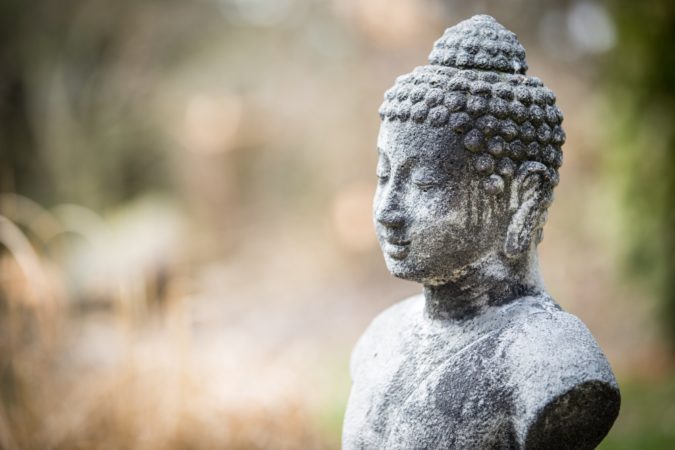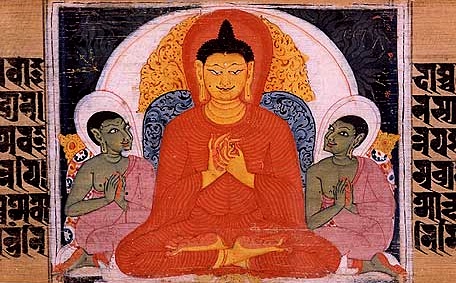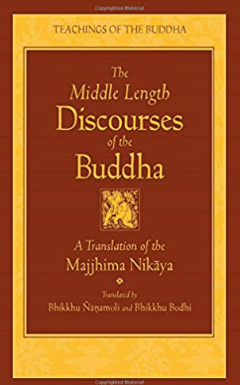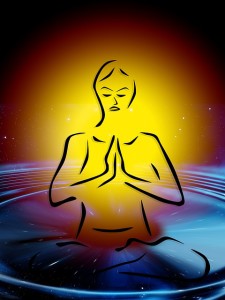
How to Practice Mindfulness in Buddhism
[Part 1 of 2] [Go to Part 2]What is Mindfulness?
Mindfulness involves purposefully paying attention to our thoughts, sensations, emotions, and feelings in the present moment. More importantly, however, it involves the acceptance and non-judgment of those thoughts, sensations, emotions, and feelings. This is not something that comes natural to us; this is something that takes practice.
Mindfulness is a key component in Buddhism. In fact, it is one of Seven Factors that can lead to enlightenment or Nirvana.
In Buddhism, we overcome suffering by practicing mindfulness. The Buddha taught that this is how we can attain peace and lasting happiness.
But How do we Practice Mindfulness?
Mindfulness is often thought of as something done during meditation practice. While this is true, the Buddha taught that mindfulness should be practiced at all times.
Being mindful at all times seems rather daunting. Fortunately, the Buddha provided us with a guide to practice mindfulness and ultimately free us from suffering. There is an entire Sutta (discourse) dedicated to understanding the practice of mindfulness. It is called the Satipatthana Sutta (Satipatthana is the Pali world for mindfulness).

A Brief History
First, a brief review of the Buddhist philosophy might be helpful in order to see where mindfulness fits in with the entire philosophy.
The Four Noble Truths
Buddhist philosophy is contained in The Four Noble Truths. The Truths are:
- There is suffering in the world
- The cause of suffering is craving or desire
- There is a way to end suffering
- Following The Noble Eightfold Path will liberate us from suffering
The Noble EightFold Path
The Eightfold Path consists of 3 types of training and 8 precepts:
I. Wisdom (Helps us to understand reality and see the world as it truly is)
1. Right Understanding
2. Right Thought
II. Ethical or Virtuous conduct (Helps us attain mental purity)
3. Right Speech
4. Right Action
5. Right Livelihood
III. Mental Discipline or Concentration (Helps us develop true wisdom)
6. Right Effort
7. Right Mindfulness
8. Right Concentration
See more detail on The Noble Eightfold Path.
It is the 7th precept (Right Mindfulness) in the Eightfold Path that is covered in detail in the Satipatthana Sutta.
The Buddha said,
…this is the direct path for the purification of beings, for the surmounting of sorrow and lamentation, for the disappearance of pain and grief, for the attainment of the true way, for the realization of Nibbana [Nirvana] – namely, the four foundations of mindfulness.
…if anyone should develop these four foundations of mindfulness in such a way for seven years…five years…five months…four months…seven days, one of two fruits could be expected for him: with final knowledge here and now, or if there is a trace of clinging left, non-return.

The Middle Length Discourses of the Buddha
The Four Foundations of Mindfulness
Now we come back to the question of how to practice mindfulness. To answer that, we look to The Four Foundations of Mindfulness.
As mentioned above, if we want to free ourselves from suffering and attain nirvana (enlightenment), we need to attain accepting and non-judgmental, moment to moment mindfulness.
The four foundations are four mindfulness practices that the Buddha teaches us in the mindfulness sutta.
The Four Foundations:
I. Mindfulness of the Body
II. Mindfulness of Feeling
III. Mindfulness of the States of the Mind
IV. Mindfulness of Mental Objects (PhenomenThon)
When we practice these Four Foundations, we will be able to understand how things truly are in the world. We are very habitual and tend to think and do the same things.
The Four Foundations allows us to look at things in ways that we normally don’t. When we are able to see what is really going on, we will see how we create our own suffering (or rather our mind creates the suffering).
I. The First Foundation of Mindfulness:
Mindfulness of the Body
It might be surprising to learn how important the body is to mindfulness practice.
The Buddha said,
There is one thing that when cultivated and regularly practiced, leads to deep spiritual intention, to peace, to mindfulness and clear comprehension, to vision and knowledge, to a happy life here and now and to the culmination of wisdom and awakening. And what is that one thing? It is mindfulness centered on the body.
When we are mindful of the body, we contemplate the body in the body and not the feeling in the body or the ‘person’ or ‘self’ in the body. The body becomes the object of meditation. In fact, everything in these meditations become objects of meditation. We see them for what the are; we see that they are not attached to anything.
The Buddha taught 6 practices or meditations for being mindful of the body.
6 Mindfulness of the Body Practices:
- Mindfulness of Breathing
- Mindfulness of the Postures of the Body
- Mindfulness with Clear Comprehension (or Mindfulness of all Activities)
- Reflections on the Parts of the Body
- Reflections on the Four Material Elements
- The 9 Cemetery Contemplations
1. Mindfulness of Breathing
The breath is where most people start with when beginning meditation and mindfulness. Here we simply feel the sensation of air coming in and going out. We are wholly aware of the breath and, therefore, the present moment. We observe the breath as it is. For example, if you breathe in a long breath you simply notice, ‘This is a long breath.’
The Buddha suggested that we find a quiet place where we can be alone. Sitting in an upright position, we set aside all worries and unfinished business and focus on the breath. We notice the relationship of the breath and the body and let go of any feelings or thoughts that arise.
As for some of the benefits of breathing mindfully, the Buddha said,
This concentration through mindfulness of breathing, when developed and practiced much, is both peaceful and sublime, it is an unadulterated blissful abiding, and it banishes at once and stills evil unprofitable thoughts as soon as they arise.
After this practice, one can then move into Mindfulness of the Postures of the Body which is the 2nd practice.
2. Mindfulness of the Postures of the Body
There are 4 basic postures: walking, standing, sitting, lying. Our attention is still on the body in the body. We bring our awareness to what the body is doing. When sitting, we are aware of the position of the legs, the hardness or softness of the seat, and so forth. At first, it might be pleasant, but after a while, it might feel unpleasant.
We make no judgment about it; we simply are aware of the changes and how they occur without us doing anything. We see the impermanence of all of these things and remain in the present moment, just observing and keeping our awareness on the body.
Our challenge is to remain detached from the sensations as they happen. We are not our body and we are not these sensations, therefore, we must not become attached to them. Once we become attached, we suffer.
After this exercise, comes the Mindfulness of All Activities.
3. Mindfulness with Clear Comprehension (Mindfulness of all Activities)
With this practice, we are aware of what we do every day. For example, brushing our teeth, eating, crossing the street. And when we have clear comprehension we know our purpose behind doing something. That is, we comprehend why we are doing something, if it is a good way to do it, if we are practicing mindfulness, etc.
There are 4 aspects to Clear Comprehension:
1. Purpose: What is the purpose of the activity? Is there good reason to engage in the activity? Am I in accord with Buddhist principles?
2. Suitability: Is this the best way to do it?
3. Domain: Am I being mindful of what I am doing?
4. Non-Delusion: Do I understand the reality of any action? Do I understand its impermanence? Do I understand the cause of suffering? Do I know that I am not identified with these things (not-self)?
All of these questions are not meant to complicate the practice. The simple idea behind Clear Comprehension is this:
– We are aware of our actions
– We know why we are performing any action
– We remain mindful while performing any action
– We understand the reality that underlies all actions (impermanence, suffering, not-self)
The next 3 practices are generally not taught in the west. They bring our attention to things that some may find uncomfortable. However, with an open mind, it is possible to see the value in the meditations. Remember the main purpose of these practices is to understand how things truly are so we can escape suffering. We must understand the impermanence of the body and how attachments cause us suffering.
4. Reflections of the Parts of the Body

The Buddhists divide the body up into 32 parts. In this practice, we visualize each part of the body as it is – like a mental dissection.
This is done for several reasons. One is to understand that we are not our bodies. The body is made up of many parts (many of them somewhat vile), yet we are not any one of them. We should, therefore, never attach to any part of the body. Meaning we should not feel shame because our teeth are crooked or pride because we have flawless skin or nice hair.
Another reason for the practice is to understand that everyone else has all of these parts. And all of their parts will change just like ours. The body is impermanent and we are not to identify with it, become attached to it, or feel disgust or pride because of it.
It is very easy to become attached to parts of the body. This meditation is not an easy practice.
As we sit, contemplating each part of the body, we see them as they are; we see their impermanence, and we understand that no part of the body is ‘me’.
The next meditation is similar to the parts of the body meditation.
5. Reflections of the Four Elements
There are four elements in the world:
- Earth (solid)
- Water (fluid)
- Air (vibration)
- Fire (heat)
When we reflect on this, we see that our body is a part of these four elements.
All bodies are made up of the same elements found in the world, the same atoms, the same everything. We can, therefore, see the body as not ‘ours’ but part of the elements or all of nature. When we die, the body will still be a part of those elements; it is a part of everything.
6. The 9 Cemetery Contemplations
Many people may find this practice challenging. The practice is used to further detach from the body and understand its impermanence. We are taken through several visualization exercises where we see the body through the process of death and decomposition. It is actually 9 meditations where we start imagining the body only a couple of days after death, to finally imagining the body as rotten bones and dust.
The 9 Cemetery Contemplations:
- A body dead a day or two (swollen, blue, thrown into the ground)
- A corpse being eaten by birds, animals, worms
- A skeleton held together only by tendons and some flesh and blood
- A skeleton held together by tendons with no
flesh, smeared with blood - A skeleton held together by tendons, fleshless and bloodless
- Loose bones scattered in all directions
- Bones bleached white by the sun
- Bones a year only lying in a heap
- Rotten bones crumbling to dust
As we contemplate, we think, ‘This body of mine, too, is of the same nature as that body, is going to be like that body and has not got past the condition of becoming like that body.’
Many people live in such fear of death that it causes them much suffering. When we use these meditations, we understand and accept reality.
We must understand that the cause of death is birth. It is healthier to accept the truth of death than ignore it and live in delusion.
The Buddha asked one of his disciples,
If there were absolutely no births of any kind anywhere – that is, of gods into the state of gods, of celestials into the state of celestials, of spirits, demons, human beings, quadrupeds, winged creatures, and reptiles each into their own state – if there were no births of beings of any sort into any state, then, in the complete absence of birth, would we discern aging and death?
His disciple answered that there certainly would not be.
The Buddha concluded,
Therefore…it is clear that there is one cause, source, origin, and condition for aging and death. Namely, birth!
This completes the First Foundation of Mindfulness. There are many parts to it, so it does take some time to cover. The final 3 Foundations: Mindfulness of Feeling, Mindfulness of the States of Mind, and Mindfulness of Mental Objects will be covered in The Four Foundations of Mindfulness Explained, Part 2.

Leave a Reply